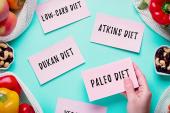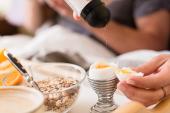Slash Dietary Sodium, Slash Blood Pressure: CARDIA-SSBP
In this crossover study where food was prepared and shipped, patients had an 8-mm Hg reduction in systolic BP in just a week.

Switching from a high-sodium diet to a low-sodium diet can significantly slash blood pressure in the majority of middle-aged and elderly adults, according to results from the CARDIA-SSBP crossover study.
With data presented this weekend during the American Heart Association (AHA) 2023 Scientific Sessions, researchers led by Deepak K. Gupta, MD (Vanderbilt University Medical Center, Nashville, TN), showed that when moving from a high-sodium diet to a low-sodium diet, the mean difference in systolic and diastolic blood pressure was 8 and 3 mm Hg, respectively.
This reduction is comparable with what’s achieved with hydrochlorothiazide 12.5 mg, a commonly used, first-line antihypertensive agent, said Gupta.
Regarding the practicality of adhering to a strict diet where patients took in just 500 mg of sodium per day as opposed to a typical Western diet of 3,500 mg or higher, Gupta believes it’s possible to make such changes. While the low-sodium diet was standardized in metabolic kitchens at two participating clinical sites, all foods were commercially available, he said.
“We need to make it simple for participants and individuals to actually be successful with their diet, whether that’s low sodium or other components,” Gupta told TCTMD, noting that there are many structural barriers to changing lifestyle. “I think making it easy for participants to see that they can do this is an important step, whether that's through apps, new technology, or even grocery stores, putting up big signs that say, ‘This is low sodium for healthy diets.”
Hypertension expert George Bakris, MD (University of Chicago, IL), who wasn’t involved in the study, said that some people aren’t even aware of the amount of sodium in their diet.
“I had two patients that were referred to me by cardiologists, advertised as resistant on three [antihypertensive] drugs, and when we measured their sodium intake—this 3 grams [per day] is a joke—they were on 10 grams a day, had no clue,” he said during an AHA press conference. “They worked with me and the dietician, and within 2 months they were off all their medicines.”
While those anecdotes might reflect rare circumstances, “do not underestimate the power of salt,” said Bakris.
John Bisognano, MD, PhD (University of Michigan, Ann Arbor), who wasn’t involved in the trial, said the new data should pull physicians back to the importance of lifestyle modification when it comes to risk prevention. “I think it's a further quantification of what's known,” he told TCTMD. “Hypertension is a field where from time to time people forget about the basics, and it's important to have a quantitative study that revitalizes and reminds us of the importance of certain things like sodium restriction.”
The study was published simultaneously in JAMA.
Salt Sensitivity
It’s been more than 20 years since the DASH-Sodium diet showed that reducing sodium levels from roughly 3,300 mg per day to 1,500 mg significant lowered systolic blood pressure by 7 mm Hg. Despite that evidence, said Gupta, the daily consumption of dietary sodium continues to far exceed recommended limits set by the World Health Organization, US Department of Health and Human Services, and AHA (2,300 mg or less).
“Part of the reason for that is there's substantial interindividual variability in the blood pressure response to higher and lower sodium consumption,” said Gupta. Additionally, studies assessing blood-pressure reduction with decreased sodium intake typically exclude patients with diabetes, hypertension, and those taking hypertensive medications. “So that leaves us with some unanswered questions,” he said.
To look at the impact of salt sensitivity of blood pressure, which is the within-individual blood-pressure response to changes in sodium intake, the researchers conducted a crossover study, with participants randomized to either a high-sodium diet or low-sodium diet for 1 week before being switched and following the other diet for another week. The CARDIA-SSBP study included 213 community-based participants aged 50 to 75 years enrolled between 2021 and 2023 in two US cities. Roughly two-thirds of participants were Black.
The high-sodium diet was achieved pragmatically such that participants continued to eat their normal diet, which already contained a large amount of sodium (4,450 mg per day). They also received sodium supplementation in the form of two bullion packets, which put them up to roughly 5,000 mg of sodium per day. The low-sodium diet was designed to provide 500 mg of sodium per day, along with 4,500 mg of potassium and 1,000 mg of calcium. With the low-sodium diet, all meals were prepared and provided to participants at no cost along with instructions not to eat anything outside the study meals. Here, sodium intake was reduced to 1,270 mg per day.
Do not underestimate the power of salt. George Bakris
From a baseline of 125 mm Hg, the high-sodium diet increased systolic blood pressure to 126 mm Hg while the low-sodium diet decreased systolic blood pressure to 119 mm Hg. At the end of the first dietary-intervention week, the mean systolic blood pressure difference between individuals on a high-sodium versus low-sodium diet was 8 mm Hg (95% CI 4-11 mm Hg; P < 0.001). Overall, the low-sodium diet reduced systolic blood pressure in 75% of participants, and roughly half had a more than 5-mm Hg reduction in mean arterial pressure on the low-sodium diet (meeting the definition of salt sensitive).
In terms of subgroups, Gupta said the response to changes in sodium was similar in people regardless of hypertension status and independent of antihypertensive medication use. “Individuals that had diabetes had a very profound reduction, but even those individuals without diabetes still saw a significant reduction in systolic blood pressure,” he said.
Short Intervention, but Effective
Kim Williams, MD (University of Louisville School of Medicine, Kentucky), a past president of the American College of Cardiology, said that while hypertension is a leading risk factor for cardiovascular disease, nutrition is the number one contributor to poor health in the United States. “If you look at the disease statistics, it’s components of the diet and sodium is one component,” he told TCTMD.
For Williams, the systolic blood pressure difference when moving from a high- to low-sodium diet is “absolutely huge” in terms of a future reduction in downstream cardiovascular events. An insufficient intake of potassium is also associated with high blood pressure, said Williams, and the US hypertension guidelines recommend potassium supplementation, preferably through dietary changes, in this setting. In this way, the high levels of potassium might have been a confounding factor in terms of the blood-pressure reduction, he said.
“There’s a way in which that's a scientific criticism and not at all an overall or clinical criticism,” he said. “These are the foods that people should be eating. Get your potassium up and your sodium down is exactly how our population should be eating now.”
As the scheduled discussant after the late-breaking presentation, Cheryl Anderson, PhD, MPH(University of California, San Diego), also emphasized that the results of CARDIA-SSBP are consistent with prior studies, but said “it’s really important that we now think about doing something with these results.” She added that dietary habits take hold early in life and often continue unchanged into adulthood.
“If we're going to have people be able to accomplish sodium targets wherever they live, work, learn, play, or pray, it really will take a change in the food system,” said Anderson.
Can It Be Maintained?
One of the downsides of the trial, said Bisognano, is that while they showed an impressive reduction in blood pressure over 7 days, it’s unknown if patients can maintain the diet over the long term.
For his part, Williams believes the low-sodium diet is one patients could follow long term. “They had so many elements of a whole-food, plant-based diet in CARDIA,” he said. “That’s the insight I’d like everybody to see. How do you get 500 mg of sodium? You eat a lot of plants, a lot of fruit. You avoid horrific things like processed meat.”
Williams pointed out that the low-sodium diet closely mirrors the dietary guidance recommended by the AHA to improve cardiovascular health. “If you reduce sodium with vasoactive plant-based oils and vegetables, with spinach and arugula and things like that, it’s not really about the sodium so much as it is about the diet that’s beneficial,” he said.
Anderson said the US food system is not set up so that people can eat a low-sodium diet. “If you look at data around fast-food intake, it is incredibly easy in this country to walk into a fast-food restaurant and in a thousand calories get almost the entire day's recommendation for sodium,” she said. “Something has to shift if we're going to be able to take advantage of the data like you’ve just heard from Dr. Gupta’s study.”
In 2021, US Food and Drug Administration put forward guidance for industry to voluntarily reduce sodium levels in 160 categories of food. Given that as much as 70% of dietary sodium is from packaged and food prepared outside the home, the goal with the guidance is get people down to an average of 3,000 mg per day. For those who work in this space, though, Anderson said the preference with the FDA guidance is to make such reductions mandatory.
Bisognano pointed out that medicine has taken a long time to accept that when advised to make lifestyle adjustments, there are a subset of people who can do it while many others can’t make it stick. Look no further than the new class medications to treat obesity, such as incredibly popular semaglutide (Wegovy; Novo Nordisk).
“I want to be cautious in how I say this, but I don’t think we ever quite addressed the fact that people do like eating salty foods,” he said. “This is part of their life, it’s part of their culture, and we're asking them to make a change they don't necessarily find pleasant to do. It’s tough. Sometimes people in the prevention field are so committed to asking people to do the right things we forget the fact that when you walk by restaurants people are in there because they like a really good meal.”
The key, said Bisognano, is to motivate people to engage more often in healthy behaviors and to moderate the unhealthier ones.
Michael O’Riordan is the Managing Editor for TCTMD. He completed his undergraduate degrees at Queen’s University in Kingston, ON, and…
Read Full BioSources
Gupta DK, Lewis CE, Varady KA, et al. Effect of dietary sodium on blood pressure: a crossover trial. JAMA. 2023;Epub ahead of print.
Disclosures
- Gupta reports no conflicts of interest.





Comments